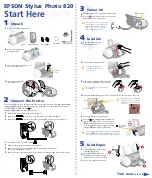
III-7
1.3.3 Development
In the development process, toner is electrically attached to the invisible statistic latent
image on the drum surface to form visible toner image on the drum.
This process is performed in parallel for yellow, magenta, cyan and black color
respectively.
•
The toner in the toner cartridge is agitated by the agitator in the toner cartridge and
fed into the toner holder. Further, the toner is fed to the developer by the auger in
the toner holder and the auger in the tube that connects the toner holder and the
developer. The agitator and auger are spiral agitating components and they are
driven by the toner motor provided on the rear of toner cartridge. The toner to be
consumed according to the print count is calculated and fed into the developer. This
is called "toner dispensation", which is controlled by two types of control, "PCDC"
and "ADC". For the PCDC and ADC, see 7.4 Process Control in this chapter.
•
The toner fed into the developer and the carrier in the developer are agitated by the
auger, and supplied to the magnet roll arranged in the vicinity of the drum surface.
The toner and carrier are charged by friction due to the agitation (toner in negative,
carrier in positive), and they are absorbed each other electrically. As the carrier is a
magnetic substance, it is attracted to the magnet roll having a magnetic force and a
homogeneous layer is formed by the trimmer rod and the paddle.
•
The magnet roll is covered by a thin semi-conductive sleeve over the surface. DB
(Developing Bias) voltage is supplied to this semiconductor sleeve from HVPS. DB
voltage is negative DC voltage combined with AC voltage. The magnet roll is kept at
constant negative voltage against the optical conducting layer of the drum by DC
voltage. Therefore, at the area on the drum surface where the negative electric
charge does not decrease, potential is lower than the magnet roll, while the potential
is higher than the magnet roll at the area where the negative charge on the drum
surface decreases. The AC voltage shakes the developer on the magnet roll
surface pressing the toner to fly to the drum.
Thus, the toner charged negatively is attracted only by the area where the minus
charge has decreased on the drum surface from the magnet roll (static latent image)
and the toner image is formed on the drum.
When the toner is attached, minus charge at that portion increases, potential
decreases, and force to attract the toner decreases.
Содержание HL-4000CN
Страница 22: ...CHAPTER I SPECIFICATIONS ...
Страница 52: ...CHAPTER II INSTALLATION ...
Страница 76: ...CHAPTER III STRUCTURE OF SYSTEM COMPONENTS ...
Страница 112: ...III 34 5 7 2 Reference diagram Transfer Roll Cartridge UNIT ASSY FUSER ASSY Exit Sensor FAN FUSER Fig 3 40 ...
Страница 129: ...CHAPTER IV ASSEMBLY DISASSEMBLY ...
Страница 132: ...2 5 21 Roll ASSY IV 74 2 5 22 Cassette ASSY front IV 74 2 5 23 Holder retard IV 75 ...
Страница 208: ...CHAPTER V TROUBLESHOOTING ...
Страница 280: ...V 70 9 IMAGE QUALITY SPECIFICATIONS 9 1 Parallelism Fig 5 10 9 2 Diagonal Fig 5 11 9 3 Skew Fig 5 12 ...
Страница 281: ...V 71 9 4 Straightness Fig 5 13 9 5 Magnification Error Fig 5 14 9 6 Registration Fig 5 15 ...
Страница 282: ...V 72 9 7 Guaranteed Printing Area Fig 5 16 ...
Страница 295: ...CHAPTER VI 5 06 ...
Страница 336: ...CHAPTER VII 3 8 3 211 725 2 7 216 ...
Страница 341: ...VII 4 P J LAYOUT DIAGRAM 2 1 IOT Top ...
Страница 342: ...VII 5 2 2 IOT Front RH ...
Страница 343: ...VII 6 2 3 MCU and HVPS PWB ESS PWB ...
Страница 344: ...VII 7 2 4 Tray1 ...
Страница 345: ...VII 8 2 5 2 Tray Module ...
















































